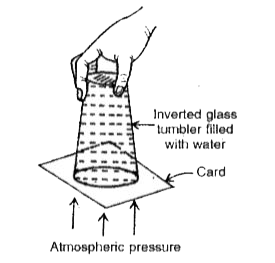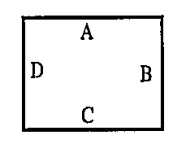Take an empty glass. Place a square cardboard on the glass. Place a 50 paisa coin on the card. Now snap the card. We will find that the card moves on, but the coin falls into the glass.

Explanation. The coin was at rest. on the card. When the card is snapped, it flies away. The coin, however, remains at rest due to the inertia of rest, and falls into the glass.
Topper's Solved these Questions
- FORCE AND LAWS OF MOTIONBOOK - NAND LAL PUBLICATIONCHAPTER - FORCE AND LAWS OF MOTIONEXERCISE - Intext Questions
10 Videos
- FORCE AND LAWS OF MOTIONBOOK - NAND LAL PUBLICATIONCHAPTER - FORCE AND LAWS OF MOTIONEXERCISE - Exercises
20 Videos
- GRAVITATIONBOOK - NAND LAL PUBLICATIONCHAPTER - GRAVITATIONEXERCISE - Additional Questions (Long Answer Type Questions)
1 Videos
Similar Questions
A classroom demonstration of Newton's first law is as follows: A glass is covered with a plastic card and a coin is placed on the card. The card is given a quick strike and the coin falls in the glass. a.Should the friction coeficient between the card and the coin be small or large? b. Should the coin be light or heavy? c. Why does the experiment fail ifteh card is gently pushed?
View SolutionA classroom demonstration of Newton's first law is as follows: A glass is covered with a plastic card and a coin is placed on the card. The card is given a quick strike and the coin falls in the glass. a.Should the friction coefficient between the card and the coin be small or large? b. Should the coin be light or heavy? c. Why does the experiment fail if the card is gently pushed?
View Solution
Knowledge Check
When a card placed over a tumbler is flicked with the finger , the coin placed over it falls in the tumbler".
ALaw of conservation of energyBNewton's third law of motionCLaw of InertiaDLaw of conservation of momentum
Arvind is a student of class IX. One day he had to visit a dentist in the morning because of severe toothache, so he reached late in the school. At that time, his classmates were doing physics experiments in the science laboratory. The science teacher, Mr. Bhatia, asked Arvind to stand alongside Rahul and observe carefully what he was doing. Rahul took a glass tumbler and placed a thick square card on its mouth. He then placed a coin above this card in middle. Rahul flicked the card hard with his fingers. On flicking, the card moved away but the coin dropped into the glass tumbler. After the experiment was over, Mr. Bhatia, asked Arvind to answer the following questions:
(a) What is the 'initial state' of the card? Why does the card move away when flicked with fingers?
(b) What is the 'initial state' of the coin? Why does coin not move away when the card is flicked with fingers?
(c) Which property of coin is exhibited by the fact that the coin drops into glass tumbler when card is flicked away with fingers and moves away? Explain your answer.
(d) What was Rahul trying to illustrate by performing this experiment?
(e) What values are displayed by Arvind in this episode?
View SolutionIn the figure shown, a light one rupee coin is placed on the card and the card is flicked with a push
State the law involved in this case

View SolutionA glass is filled with water up to its brim and a thick hand card placed on top of it. Now keeping the card tightly closed and pressed with palm, the glass full of water is inverted and placed upside down. The palm is gently removed from the card. It is observed that the piece of card does not fall off the glass though the glass is full of water and its whole weight is exerting pressure on the card. Why does it happen?

View SolutionPlace a coin at the bottom of a glass jar containiing water. Now tilt the jar suitably. When viewed at a suitable angle, the coin appears to be floating . Why ?
View SolutionLetters A, B, C and D are written on a cardboard as shown in the figure below. The cardboard is kept at a suitable distance behind a transparent empty glass of cylindrical shape. If the glass is now filled with water, one sees an inverted image of the pattern on the cardboard when looking through the glass. Ignoring magnification effects, the image would appear as

View SolutionWhy does a coin, placed on a card, drop into the tumbler when the card is rapidly flicked with a finger?
View SolutionIn the figure shown, a light one rupee coin is placed on the card and the card is flicked with a push
What do you observe in this case and explain your observation ?

View Solution
